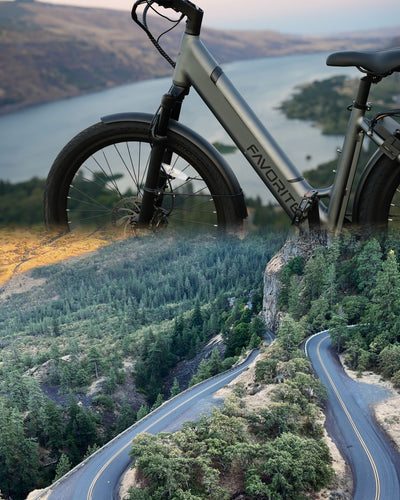
Electric Bikes vs. Mopeds: Which Is the Best Option for You?
Table of Contents
Electric bikes (e-bikes) and mopeds have become increasingly popular as eco-friendly alternatives to traditional transportation. Both are excellent options for commuting, running errands, or enjoying leisurely rides, but they serve different needs. Whether you're looking for speed, portability, or cost-effectiveness, the choice between an e-bike and a moped boils down to your lifestyle and preferences.
In this blog, we’ll explore the key differences between electric bikes and mopeds, from performance to environmental impact, to help you decide which one is the best fit for you.
Speed and Performance
Speed is one of the main factors people consider when choosing between an e-bike and a moped.
- Electric Bikes: Depending on their classification, e-bikes can reach speeds of 25 km/h (Class 1 and 2) to 45 km/h (Class 3).
- Mopeds: Typically, mopeds can reach speeds of up to 30 km/h, though some models go faster.
While mopeds often boast higher top speeds, e-bikes shine in urban environments due to their agility. They allow riders to navigate through traffic, cycle lanes, and crowded streets with ease. For example, lightweight e-bikes like the FavoriteBikes offer a balance of speed and maneuverability, making them an excellent option for city commuters who want to zip through congestion efficiently.
Portability and Weight
Portability is another major distinction.
- E-bikes: Weigh between 20-25 kg, making them easy to carry up stairs, store in small spaces, or transport on public transit.
- Mopeds: Typically weigh between 45-90 kg, requiring a designated parking spot or larger storage space.
If you live in an apartment or frequently need to carry your bike, an e-bike is the clear winner. the FavoriteBikes, for instance, is designed for urban commuters who need a lightweight and portable option for daily travel. In contrast, mopeds are heavier and less convenient for storage or multi-modal travel.
Power Source and Range
Both e-bikes and mopeds offer electric power, but how they use it differs significantly.
- Electric Bikes: Provide a range of 40-80 km per charge, depending on the battery size and level of pedal assistance. Riders can extend this range by pedaling when the battery runs low.
- Mopeds: Typically offer a longer range of up to 160 km on a full tank (or full charge for electric mopeds).
If you’re looking for versatility, e-bikes are the better option. Their hybrid nature—combining pedal power and electric assistance—ensures you won’t be stranded even if the battery dies. Plus, the added pedaling can contribute to your fitness goals, making e-bikes a practical and healthy choice for daily travel.
Cost and Maintenance
Initial costs and long-term expenses vary significantly between the two options:
- Electric Bikes: Prices range from $500 to$4,000 for premium models, such as those offered by FavoriteBikes.
- Mopeds: Entry-level mopeds can cost as little as $800, with higher-end models costing more.
Maintenance Costs
- E-bikes generally have lower maintenance costs because they lack a combustion engine and require minimal servicing. You’ll only need to maintain the chains, brakes, and battery.
- Mopeds require regular engine maintenance, oil changes, and fuel system checks, which can add up over time.
Additionally, charging an e-bike battery is significantly cheaper than fueling a moped. For daily commuting, this makes e-bikes the more economical option in the long run.
Environmental Impact
Both e-bikes and mopeds are greener than traditional gas-powered vehicles, but e-bikes are the clear sustainability champion:
- E-bikes: Produce zero direct emissions and consume minimal energy.
- Mopeds: Even electric mopeds consume more energy due to their heavier build and more powerful motors.
E-bikes reduce fossil fuel dependence, noise pollution, and traffic congestion in cities. As urban areas strive to become more sustainable, e-bikes are emerging as a key player in promoting eco-friendly transportation.
Legal Requirements
Legal regulations often favor e-bikes due to their accessibility:
- E-bikes: Most models (Class 1 and 2) don’t require a license, registration, or insurance.
- Mopeds: Typically require a driver’s license, registration, and insurance, adding extra steps to ownership.
If you want to avoid the hassle of paperwork and additional costs, an e-bike is the better choice. However, be sure to check your local laws, as high-speed e-bikes (Class 3) may have stricter regulations.
Who Should Choose an E-Bike?
An electric bike is the best option if:
- You’re a city commuter who values portability and flexibility.
- You want an eco-friendly, zero-emission vehicle.
- You’re looking for an affordable long-term solution with low maintenance costs.
- You’d like to incorporate light exercise into your daily routine.
- You need a vehicle that combines electric assistance with manual pedaling.
Who Should Choose a Moped?
A moped might be the right choice if:
- You need a higher top speed for longer, uninterrupted trips.
- You don’t mind the additional weight and maintenance requirements.
- You’re looking for a vehicle powered solely by a motor, with no need for pedaling.
- You prioritize range over portability or exercise benefits.
The Verdict: E-Bikes or Mopeds?
In the battle of electric bikes vs. mopeds, there’s no one-size-fits-all answer. Your choice will depend on your lifestyle, commuting habits, and personal preferences.
If you value sustainability, portability, and the versatility of combining pedal power with electric assistance, an e-bike is likely the better option. For those who need higher speeds and longer ranges without the effort of pedaling, a moped might be the way to go.
At FavoriteBikes, we offer a range of high-quality e-bikes tailored to meet the needs of modern commuters and leisure riders. Models like the Ampler Curt and Ampler Axel combine lightweight designs with powerful battery ranges, giving you the perfect blend of performance and convenience.
Ready to make the switch? Explore our e-bike collection today and find the perfect match for your urban mobility needs.
No comments










0 comments